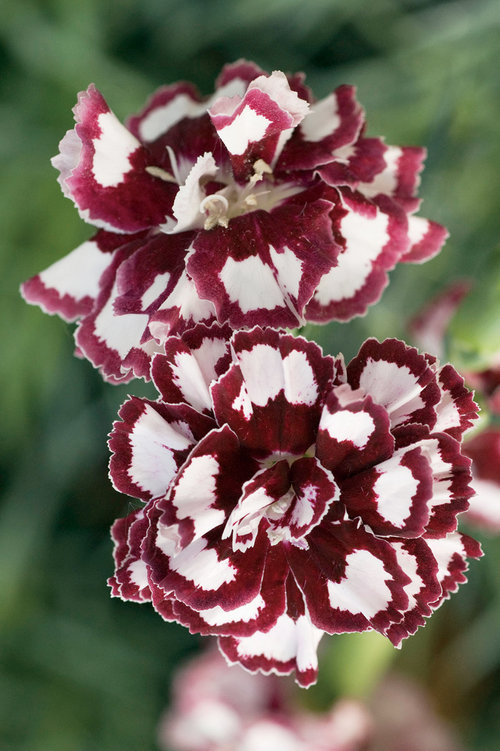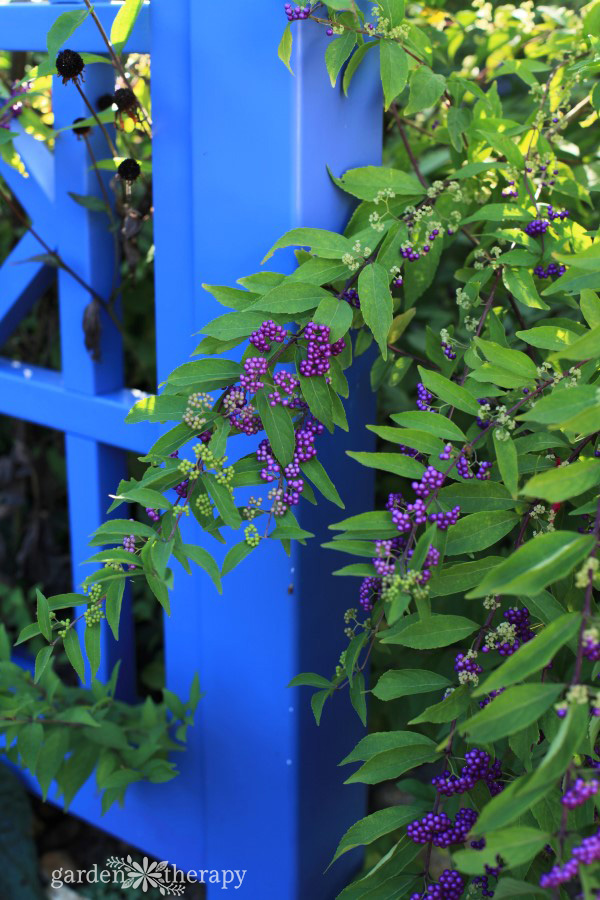Did you know you can stop allergies and asthma with smart landscaping? It’s true! In this post, I will be discussing the best plants for allergies that you can use to create an allergy-free garden at home.

Allergy sufferers rejoice! You don’t have to be afraid of the garden. You read that right: you can STOP allergies and asthma with having the right plants in your home garden.
Plants That Can Actually Help Allergies
If you suffer from allergies, I’m sure you’ve probably thought that plants and the outside world are the enemy. With all of their pollen irritating your eyes and nose, it’s easier to just avoid them altogether.
I’ve got the best news for you…you don’t have to avoid them anymore! All you need to do is to plant the right kinds of plants.
There are plants that can actually purify the air that we breathe.

The Allergy-Fighting Garden
If you are one of the millions of people with allergies or asthma, then you are going to want to read what horticulturist Thomas Ogren has written in his book, The Allergy-Fighting Garden. This totally unique book shows you how to avoid plants that trigger allergies and to create a garden that will actually protect you by trapping pollen and cleaning the air around you.
According to Thomas, combating allergens all came down to the crucial matter of plant sex, specifically how it influenced pollen allergies. By replacing troublesome male plants in your yard with pollen-blocking female aka “pollen screens,” those who suffer from seasonal allergies can reduce or eliminate their symptoms.
Personally, I think this book is a must! Trying to decipher which plants cause no allergies and those which can cause severe allergies can be very difficult- and Ogren’s book makes it much easier. There are more than 3,000 plant listings (trees, shrubs, flowers, etc.) included and it’s even accompanied by an easy-to-use allergy ranking scale of 1 to 10!
I have learned so much from his book and I wanted to share some of the fascinating info with you. I’ll also share the list of the top 10 allergy-fighting plants you can add to your garden today!
OPALS™ – The Allergy-Fighting Scale of Plants
When writing The Allergy-Fighting Garden, Thomas Ogren created a new system called OPALS™ that has become a huge game-changer in the gardening community.
OPALS™ is an abbreviation for “Ogren Plant Allergy Scale“, although it is sometimes said to mean “Ogren Pollen Allergy Scale”. The scale runs from 1-10, where 1 is allergy-free and 10 is the worst for an allergenic.
Here is a more detailed rating guideline:
- OPALS™ Rating 1–3: None to low allergy symptoms
- OPALS™ Rating 4-6: Moderate potential to cause an allergic reaction by constant exposure
- OPALS™ Rating 7-8: High risk of an allergic reaction
- OPALS™ Rating 9-10: Extremely severe potential in terms of allergic reactions
You will find that many of the #1 ranked plants will be all-female selections while many (but not all) of the #10 ranked plants will be all-male clones.
Female plants (which shed no pollen at all) are allergy-fighting because they trap and remove pollen from the air!
OPALS™ makes it possible for gardeners to create their own landscapes that are completely allergy-friendly.
Although OPALS™ is focused on pollen prevention, there are other allergenic factors taken into consideration when regarding the rankings given on the allergy scale.
In particular:
- Odd odors
- Fragrances that might trigger allergies
- Particular plants that can trigger skin rash or itch through close contact
The actual amount of pollen produced is an important factor, but, more important, is the potency of the pollen.
10 Best Plants For Allergies To Add To Your Garden
Alright allergy-sufferers, are you ready to find out which plants you need to grow that will help purify your air and actually help your allergies? Here they are!
These are the 10 best plants for allergies that you can find.
1. Pansies
Pansies produce a tiny bit of pollen and it never seems to make anyone ill. They are entirely insect-pollinated and grow well when the season is cool.
Pansy also includes their smaller cousins, the Violas!
OPALS™ Rank: 1

2. Hollies
Hollies (Ilex species) are very easy to distinguish by sex; the female plants make red berries and the male plants make none.
Male Holly plants can trigger allergies and many new female cultivars (such as ‘Nellie Stevens’) will make a good crop of red berries even without any males around.
Never buy a Holly plant unless it already has some berries on it; they’re your assurance that you’re getting a pollen-free female plant.
OPALS™ Rank: 1

3. Impatiens
Impatiens come in many colors and sizes, but all of them thrive in partial shade with good moisture. Like the Pansy, each pollen grain in an Impatiens flower is large, sticky and does not become airborne.
Easy to grow and very floriferous, all kinds of Impatiens are terrific allergy-friendly garden flowers!
OPALS™ Rank: 1

4. Catmint
Nepeta nervosa, Catmint, is a shade-loving hardy perennial that produces little pollen but a great deal of sweet nectar, making it a favorite of pollinators.
Easy to grow and easy to propagate from cuttings, Catmint is a good addition to almost any shady garden spot!
OPALS™ Rank: 2

5. Sweet Williams
Dianthus, or Sweet Williams, are short-lived perennials that thrive under the full sun. Easy to grow, quick to flower, and fast to re-bloom after deadheading, there are hundreds of fine cultivars of Dianthus.
Many forms will lack all (pollen-bearing) stamens, and be essentially all-female plants. These all-female Dianthus are OPALS™ 1, but no type of Dianthus ranks higher than 3.
OPALS™ Rank: 1

6. Beautybush
Beautybush, or Callicarpa dichotoma ‘Early Amethyst,’ is a small, shrubby, deciduous perennial, hardy in zones 5-10.
‘Early Amethyst’ makes a small amount of pollen but the plant is mostly female and, being self-fertile, sets a good crop of fabulous-looking berries each year. It tends to flower on new wood, so prune it back in very early spring.
OPALS™ Rank: 2

7. Snapdragons
Snapdragons, or Antirrhinum majus, are hardy annual flowers for all zones. During hot summers, snapdragons tend to grow well in mild winter areas.
The pollen in each flower can only be accessed when opened (usually by a bumblebee) and then it snaps shut as soon as the bee leaves.
It’s one of the best level one plants to fight allergies!
OPALS™ Rank: 1

8. Cigar Plant
Cuphea, or Cigar Plant, is a half-hardy perennial for the warmest zones and used as an annual in zones 7-3!
Easy and fast to grow, quick from cuttings, the little purple flowers attract many native pollinators and shed next to no pollen.
OPALS™ Rank: 2

9. Woodland Sage
Salvia nemerosa (Woodland Sage) is a perennial hardy in zones 6-10. Easy for cuttings, the flowers make no pollen but are very rich in nectar, making them attractive to native bees, butterflies, and hummingbirds!
OPALS™ Rank: 1

10. Cranesbill
Cranesbill, or Erodium spp., are evergreen perennials from zones 8-10 who thrive best in the shade in hot inland areas.
This plant is grown as a semi-hardy annual in colder areas and it is always attractive, free-flowering and pest free. Related to true Geraniums, Cranesbill is quite allergy-friendly!
OPALS™ Rank: 2

Pollen-Free Plants For Allergies
This post was just a taste of what you could potentially uncover in Thomas Orgen’s book, The Allergy-Fighting Garden.
With so many new pollen-free plants to choose from, as well as clearly marked “worst offenders” to avoid, this is the ultimate resource for home gardeners and professionals alike who want to build healthy, safe, and beautiful gardens that everyone can enjoy!
A special thanks to Proven Winners for providing some of the photos for this article, showcasing gorgeous varieties of allergy-fighting plants.
Reprinted with permission from The Allergy-Fighting Garden by Thomas Leo Ogren, copyright (c) 2015. Published by Ten Speed Press, a division of Penguin Random House, Inc. Photography (c) 2015 by Tom Ogren.





Great! OPALS makes it possible for gardeners to create their own landscapes that are completely allergy-friendly.